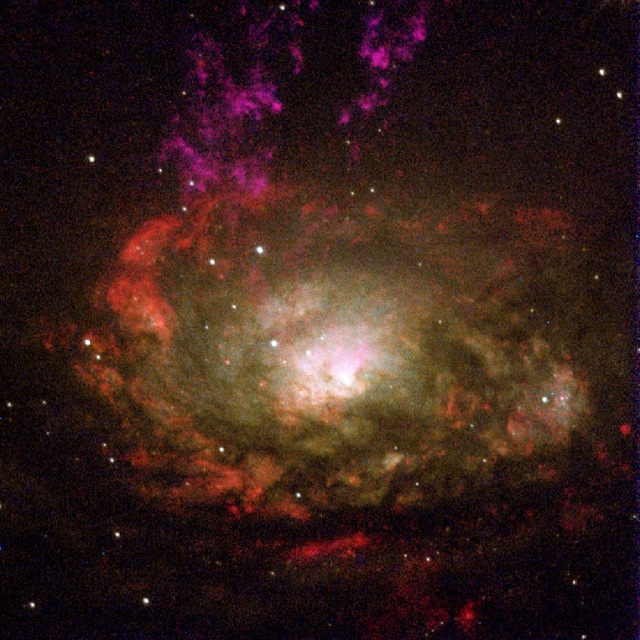By Annelies Rhemrev
October 14, 2012
Circinus Galaxy, an active spiral galaxy in Circinus
Image Credit: Andrew S. Wilson (U. Maryland) et al., WFPC2, HST, NASA
For a larger image click here.
Circinus Galaxy (ESO 97-G13), is an active spiral galaxy (Type Seyfert II), located about 13 million light-years away in the Circinus constellation, just below the Galactic plane. The Circinus Galaxy is one of the closest known active galaxies to the Milky Way. It is receding form us at 434 kilometers per second.
Seyfert galaxies are galaxies with extremely bright nuclei that produce spectral line emission from highly ionized gas. The centres of Seyfert galaxies have active galactic nuclei (AGN), and usually contain supermassive black holes with masses between 10 and 100 million solar masses. Seyferts are classified as Type I or II, depending upon whether the spectra show both narrow and broad emission lines (Type I), or only narrow lines (Type II).
Circinus Galaxy consists of extended spiral arms and, at the center, an active galactic nucleus, where matter glows brightly before spiraling into a supermassive black hole. The inner spiral arms of the galaxy contain hydrogen-rich star forming regions.
The galaxy is undergoing tumultuous changes, as hot gas, colored pink, is being ejected out of the spiral galaxy from the central region. Much of Circinus’ tumultuous gas, however, is concentrated in two rings. The outer ring, located about 700 light-years from the center, appears mostly red and is home to tremendous bursts of star formation. An inner ring, inside the green disk, is visible only 130 light years from the center.
Circinus Galaxy was a home for the Type II supernova SN 1996cr, that has been identified over a decade after it exploded. The supernova was first singled out in 2001 as a bright, variable object in a Chandra image, but it was not confirmed as a supernova until years later.
A Type II supernova results from the rapid collapse and violent explosion of a massive star. A star must have at least 8 times, and no more than 40–50 times the mass of the Sun for this type of explosion. It is distinguished from other types of supernova by the presence of hydrogen in its spectrum. Type II supernovae are mainly observed in the spiral arms of galaxies and in H II regions, but not in elliptical galaxies.
The Circinus Galaxy went unnoticed until the 1970s because it is so obscured by material in the plane of our own Galaxy. However, the galaxy can be seen with a small telescope.
This image is taken by the Hubble Space Telescope.
Read more on Anne’s Astronomy News



